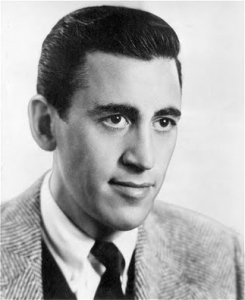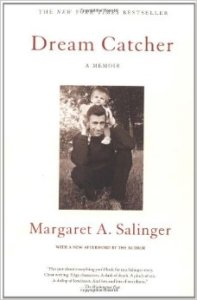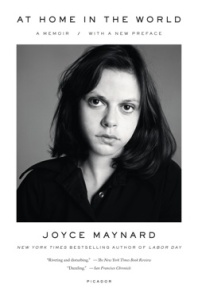Tags
Catcher in the Rye, Holden Caulfield, J.D. Salinger, Joyce Maynard, Margaret "Peggy" Salinger, narcissism
At a recent book club meeting, we read and discussed the classic “Catcher in the Rye” by the notoriously reclusive (and now deceased) J.D. Salinger. It was a book I hadn’t read since probably my late teens or early 20s – the usual age when people seem to gravitate to the book. It seems to have been written for teens and young adults. But that’s not the only age demographic to whom the books appeals.
Reading it again, I found that its character of Holden Caulfield, and his youthfully cynical perspective on life, still holds power over me. To be sure, Holden is disillusioned with life as he teeters on the cusp of adulthood. Finishing the book, I found I’d fallen in love with Holden once again.
A particularly meaningful passage for me was the scene in the Natural History Museum in New York, where Holden lingers by the exhibits that never change – the deer drinking at waterholes and the birds in midflight, perennially aloft. “The best thing, though, in that museum was that everything always stayed right where it was. Nobody’d move,” Holden remarks. To me, it’s symbolic about his reticence to leave childhood behind and his desire for things to remain the same.
Having finished this book, I – like so many other readers — wanted to know more about the mysterious Salinger, the author with the brooding eyes and handsome face. I watched the 2013 documentary titled “Salinger” and learned more about his reclusiveness, his absolute absorption in his writing and the life of his characters – a habit that often meant the neglect of his second wife, Claire Douglas and their two children, Margaret and Matthew – as well as his interest in holistic and alternative medicine, and his embrace of Eastern religions and later Scientology.
The documentary also led me to discover that his daughter and memoirist, Margaret “Peggy” Salinger and the woman with whom he lived for 11 months – the writer Joyce Maynard, had written books about the lives they shared with the reclusive author.
I ordered both their books online and read Peggy’s first, “Dream Catcher” and then Joyce’s, “At Home in the World.” I was eager to know what it was like to live with a man who was engulfed by his own creative endeavors. I was also particularly interested in knowing about Joyce’s experience, considering that she was still a teenager when she met Salinger, who at the time was 53. Salinger was notorious for his attraction to women vastly younger than he was and that intrigued me, since it mirrored a relationship I had had with a man considerably older than I was that similarly lasted only 11 months and ended just as abruptly as Joyce and J.D. Salinger’s.
What I learned was that J.D. Salinger, or as he’s known to his familiars as Jerry, was Holden Caulfield (or should I say Holden Caulfield was Jerry Salinger). He was literally channeling himself through his character of Holden. I also learned, through the pen of Peggy and Joyce, that while Salinger was charming and charismatic, he also was narcissistic, self-absorbed, discontent, contemptuous and critical of others while unable to accept criticism towards himself, manipulative and in many instances an abusive person.
Peggy’s memoir is voluminous at about 450 pages, which are filled with copious footnotes. It is towards the end of her book where I find particular meaning. As she’s grown and has her own child, she reflects back on her life with her famous father. She recalls a conversation she had with him and what she says to him about his selfishness as a father:
“You’ve never once inconvenienced yourself for your children. You’ve never interrupted your precious work. You’ve always done exactly what you wanted, when you wanted,” she writes on page 416 of “Dream Catcher”.
She very succinctly articulates what I think most children feel but are unable to express growing up with a parent who is self-absorbed. It’s only when these children grow up that they are able to see the self-absorption for what it is: abuse and neglect. I can relate to this with my own father. I also found Peggy’s following words profound:
“In giving up the dream of a perfect Daddy, some of my memories of happy times with my father returned. These are real and I know they belong to me. … Similarly, in giving up my pursuit of the heavenly Daddy, the nightmare of the hellish Daddy began to give up its pursuit of me. I am able to see a talented man who, like the rest of us, is neither all good nor all bad” (p. 431).
That’s an important lesson I think for all of us as we relate to our parents. Our parents are human though as children we make them into gods. We all expect our parents to care for us selflessly and when they don’t, it’s a great disappointment. It causes us to wonder what we did as people to not have their undivided love and support. It’s not about us though. Everyone has flaws and everyone does the best with the life skills that they have. Take nothing personally — not even the way your parents raised you.
Reading Joyce Maynard’s book, I was moved by its unflinching honesty. Both admired and reviled at the time the book was published in 1998, I found myself marveling at how Joyce puts it all out there, warts and all. She writes about how Salinger first began writing to her after she was published in the New York Times at 18; how quickly she became swept up in a relationship with him; and how he convinced her to leave Yale University and to live with him at his home in rural New Hampshire. She talks about her worship of Salinger; her inability to consummate her relationship with him; and the very abrupt and cold way that Salinger cuts her out of his life when he has no more use for her.
She lives with so many questions for so many years about her relatively brief but very intense relationship with Salinger, the same questions that filled my head about the intense relationship I shared with an older, charismatic man and lost in similar fashion.
At the age of 44, Joyce finally confronts Jerry about their relationship. She asks him, ‘What was my purpose in your life?’ Salinger is literally unable to answer that question, spewing back, “That question is too profound. You don’t deserve an answer to that question.”
It’s not because she doesn’t deserve an answer that she doesn’t get it. It’s because men like Salinger have no insight into their actions and don’t know why they do the things they do. What attracts a 53-year-old man to a teenager and asks her to give up her life to be with him only to cut her out of his life not even a year later?
It’s at that moment of confrontation, so many years after the breakup, that Joyce discovers she feels sorry for him and only wants to let him go. He accuses her of wanting to exploit their relationship in her book. Joyce knows the truth though … that she as a teenager was the one who was exploited by Salinger. As abusers are wont to do, he denies her reality.
“I didn’t exploit you,” he says. “I didn’t even know you.” (p. 344).
What a chilling thing to say.
It’s interesting about charm and charisma. These qualities can be intoxicating. In someone innocent, they are pleasing and benign. But when used by someone with ulterior motives, they can ultimately defile the innocence of others, turning a naïve and trusting person into someone full of cynicism and self-doubt — kind of like Holden Caulfield.
Salinger’s book, I’m sure, will live on forever. Holden’s voice will continue to charm countless others. There’s even word that more of Salinger’s previously unpublished work will be released this year. I’ll be curious to read it. But it’s interesting how authors morph themselves into their own fictional characters, revealing at what age they’ve essentially held themselves in arrested psychological development.
Reading Peggy and Joyce’s books was a fascinating look into their own realities and into the life of an author who had a hard time dealing with reality. Salinger seemed also to have trouble with aging, taking responsibility for his actions, and simply just growing gracefully into maturity. It’s as if Salinger, like Holden Caulfield, was reticent to let go of youth – or the next best and viable alternative to him: living vicariously through the youth of others.
What recollections do you have of reading “Catcher in the Rye”? What about the book appealed to you most or least? What do you like best (or least) about Holden Caulfield?




Your comments on both of these are thoughtful and balanced. I’ve also read Dream Catcher and Joyce Maynard’s book. Regarding the latter, I find it very hard to believe that J.M’s book is anything more than sensation-seeking. Given that she had many other responses to her article from men of her own generation, she could have pursued any one of those but she chose to pursue Salinger. I also find it creepy that her own mother made her a “little girl” dress for her initial meeting with Salinger, set of with a pair of “Mary Jane” shoes (as if she wanted to appear as little-girlish as possible).
I am not exonerating Salinger, and I’m not downplaying the bewilderment J.M. felt at his final treatment of her, but I also get a strong impression that she and her mother were setting him up, and that he was of a frame of mind to be easily set up. I also think it has to be taken into account that Salinger was a narcissist. He had, without doubt suffered Post Traumatic Stress while serving in counter-intelligence in WW2. His difficulties in getting published before CITR were not made easier by his often grandiose ideas about himself and an arrogance born, as most arrogance is, of feelings of unworthiness. I suspect his treatment of women was the result of deeply conflicting ideas about them (attraction-repulsion to put it simply), and that he might never have sought or wanted to seek psycho-therapeutic help (as he very likely didn’t feel there was a problem but that he was always in the right).
In short, I find J.M’s book cruel. If you truly love someone (as she constantly repeats she did love Salinger), would you not, over the decades have developed some insight into that person, and out of that love you had for them, to not hurt them further, especially knowing how much he valued his privacy? I feel he made a severe error of judgment in getting involved with her in the first place – which shows us how fragile he was, really.
Margaret’s book on the other hand is beautifully literate but contradicts itself often. for example, we hear about his faddy diets but then she, later in the book, details what gorgeous breakfasts he cooked and how delicious his home-made soups were. He loved taking his children out to eat and give them treats. It’s interesting that Salinger’s son, Matthew, refuted his sister’s stories, saying that he didn’t recognise the parents she was describing.
I believer Salinger’s issues were very much products of him trying to control his world – issues that had roots in childhood and later, his war experiences. There’s a great deal of anger in his writing (as seen in Zooey’s hectoring of his sister Franny, for example, while Franny can’t get a word in edgeways) as well as much lyrical beauty. He seemed to be a deeply conflicted man, and in examining him and the stories he wrote as well as those written about him,
Do read Kenneth Slawenski’s “J.D. Salinger: A Life”. It’s very good, despite not having an index at the back, which would have been helpful.
In the end, I think that we need to view Salinger with compassion, given what we can can perceive of him through his writing (he said if you want to know about him, read his work).
LikeLike
Thanks for your comments, Belinda. It’s great to come across a person who has read the books I have about Salinger’s life and the women who were part of his life. I appreciate your insights into Joyce Maynard’s relationship with J.D. Salinger, and about him and his own background and personality. I sometimes wonder how Joyce wrote a book like that — one so personal and explicit. I would have been embarrassed by some of the things she writes about had they happened to me. I suppose though that she felt this was her story and that she had every right to write about it. I thought Margaret’s book was good, a little long and with so many footnotes, they become distracting. I know others have commented about this. I have heard very good things about Kenneth Slawenski’s book about Salinger so I will pick that up at some point. Thanks again for your comments!
LikeLike
Lizscribe, Thanks also for your comments. Another book that stands out is Thomas Beller’s “The Escape Artist”. It’s a short biography of JDS and doesn’t dip at any time into sensationalism, as opposed to Shields and Salerno’s book, which is a sort of National Enquirer gossip column disguised as something academic. I’ve read all of these books in a reference library, so haven’t bought my own copies although I might well buy Beller’s. He’s got a great track record as a writer / biographer and his research here is thorough. You might also like to hear an interview that Margaret Salinger did on NPR in 2000. Link here, if that’s OK: http://thedianerehmshow.org/shows/2000-09-13/margaret-salinger-dream-catcher-washington-square-press (or google Margaret Salinger NPR Rehms)
I imagine her father was terribly hurt by her book. One episode she wrote about was kind of sad – that when she was at Oxford, he flew over to see her but she was in Portugal and when they finally met in London, he was miserable with his hotel room and hadn’t tried to get a different one. She says he seemed powerless. All that way to see his “swell girl” and she wasn’t there – a journey made out of his love for her, surely.
I like to think that he found some peace with Colleen. At the end of the film, “Salinger”,(bad though it is), it’s clear the film team has been set up by the man himself. The smiles on his and Colleen’s faces are a pleasure to see. I hope he died a happy man.
LikeLike